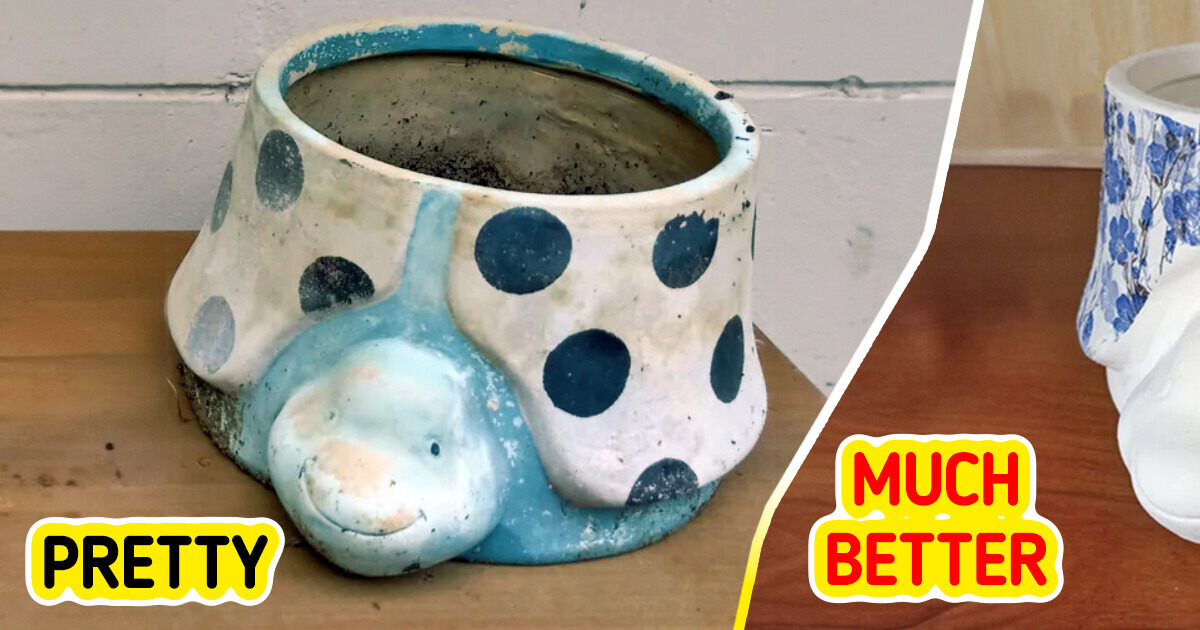16 People Who Can Outsmart Sherlock Holmes


According to an article in WebMD, spending time on a hobby can reduce cortisol levels (the stress hormone) and improve emotional well-being. So today we bring you a list of hobbies that are unusual, fun and, best of all, perfect to do at home. Some may spark your creativity, others may challenge your patience, but they all have one thing in common: they will help you switch off and bring down a change.
If you ever wanted to have a little piece of nature floating in your home, kokedama is for you. This Japanese technique consists of growing plants inside a ball of earth covered with moss and wrapped with thread. You can hang it in the window or let it rest on a decorative surface, and best of all, it’s easier than it looks.
To start, you need the base, which is a mixture of sphagnum moss, peat moss and potting soil. You will also need waxed thread or fishing line to hold everything together, as well as scissors, a bowl and gloves (if you don’t want to end up with your hands full of soil). The choice of plant is key: it is best to opt for one with small roots and slow growth, such as peperomia, ivy, ferns or succulents.
To assemble it, mix the soil with water until it forms a firm ball. Separate it in two, place the plant in the center and close it again. Then, wrap the ball with damp moss and tie it with thread, making sure that everything is well secured. If you want to hang it, leave one end of the string long.
Watering is key to keeping the plant healthy. Soak the ball in a bowl of water for 5 to 10 minutes until it feels heavy. Repeat the process whenever you notice it is light, usually every few days. Also, every two weeks add soluble fertilizer to the water. If the plant is overgrown and seems stressed even though you water it, it’s a sign that it needs a new home... or a bigger moss ball.
Creating your own kokedama is a relaxing and creative way to bring a little green into your home.
Knapping, also called flintknapping, is an ancient technique used to carve stones and minerals to create tools. Since prehistoric times, this skill has been essential to human survival, facilitating the manufacture of sharp objects needed for cutting and building. Learning this art not only allows us to learn more about our past, but it is also a practical skill for getting around in nature.
Among the most suitable materials for this practice are flint, chalcedony, obsidian and other types of volcanic glass, since their fracture follows predictable patterns when struck with a hammerstone.
The carving process begins with the choice of a stone without fissures or imperfections, from which the surface layer is removed by controlled blows. Then, using a hammerstone, flakes are removed to shape and sharpen the tool. This procedure requires dexterity and patience, as excessive pressure or too abrupt blows can cause unwanted fractures.
To practice knapping safely, it is essential to wear eye protection and avoid holding the stones with bare hands, using gloves or suitable supports. In addition, it is advisable to start with small fragments before working with larger pieces and experiment with different types of stone to identify which is best suited to each need.
Perfecting this technique not only links us to our ancestors, but also provides us with a valuable tool for life in natural environments.
Yes, it may seem like a common hobby, but origami is a fascinating art that has spanned centuries of history and has reached impressive levels of complexity and creativity. Origami is the art of folding paper to create both two- and three-dimensional objects.
Although origami traditionally involved cutting paper, today most practitioners, known as “folders,” prefer not to use scissors, except for a few variants such as the Rokoan style, which connects cranes. In general, origami is done with square paper, but other types of paper are also used, such as rectangles or modular shapes, which may require multiple sheets for a single work. The simplest designs can be made in a few minutes, but more complex ones can take hours of dedication.
Some prefer almost cartoonish creations, with sequences of simple folds, while others seek very detailed representations, requiring advanced techniques. To achieve this, diagrams with symbols and arrows that are easy to find on the Internet are used to describe the folding sequences precisely, allowing the art to be learned without the need for a common language.
There are different styles within origami, ranging from realistic models, with complex sequences of folds, to those more minimalist, which capture the essence of the figure with few movements. There are also styles such as modular origami, which uses multiple sheets of paper to form geometric figures, or tessellations, where the fold becomes a repetitive pattern.
Another interesting technique is wet folding, invented by Akira Yoshizawa, which involves slightly moistening the paper so that it can be folded into smoother, more durable shapes. This diversity of styles and techniques reflects the enormous creative richness of origami.
In short, origami is much more than just a hobby: it is an art form that transcends cultures and generations, combining patience, creativity and precision. And best of all, anyone can learn it, regardless of language or culture.
This sculpting technique, as simple as it is fun, allows you to transform a block of soap into a work of art, and best of all: no need to be an expert sculptor!
To get started, all you need are a couple of basic materials. First, of course, is a soft soap, such as Ivory soap, which is ideal for its texture and ease of workability. You’ll also need to get some popsicle sticks or a butter knife (yes, those kitchen utensils we all have at home!) to shape your sculpture. And the final touch? A little patience and creativity!
The process begins when you remove the soap wrapper and smooth its surface. This is done by rubbing the long edge of a popsicle stick across the soap, removing a thin layer to leave a smooth surface ready for sculpting. Then the magic begins! With the pointed end of the stick or the butter knife, start sketching the design of your choice: you can make abstract shapes, geometric figures, or even animals. As you go along, remove the soap from the areas that are not part of your design, creating what is called a relief (like a 3D sculpture!).
It’s important to start slowly, don’t rush and, above all, don’t forget to work all the angles of the piece, so that your sculpture looks impressive from any perspective. You can use the rounded part of the stick to scrape the larger areas and give a more precise shape to the thin edges, and that’s it! Once you’re done, you’ll have a one-of-a-kind piece and, best of all, made by you!
So, if you’re looking for a fun and creative activity, soap carving is perfect for you. Besides being relaxing, it gives you the opportunity to explore new forms of art, and best of all, you can make great sculptures without getting too dirty! Are you up for trying it?
Needle felting is a creative way to make figures, drawings and even jewelry using only wool and a special needle. This technique is economical, clean and very portable, ideal to take on trips or to make in small spaces. The process consists of pricking the wool with a special needle that has notches, which causes the fibers to intertwine and compact, creating 2D or 3D figures.
To get started, all you need are felting needles, a foam base and wool fiber. Felting needles come in different sizes and thicknesses, and you can start with a thicker needle to shape the wool quickly, then use a thinner one for details. The wool fiber is also varied: from carded wools for larger figures to fine, shiny wools for small details. You can create anything from 3D figures to 2D patterns, and customize the colors and textures according to your imagination. In addition, you can use other materials such as wires for structures or pipe cleaners to stiffen the figures.
If you want to give it a try, you can start with a simple project, such as making a small fantasy mushroom. You just need to make a ball of red wool for the hat and a roll of white wool for the stem, then join the two parts together — it’s easy and a lot of fun. Needle felting is great for anyone looking for an accessible and creative art form — you’ll be amazed at what you can create with just wool and a needle!
Flower pressing is a simple technique that allows you to preserve the beauty of plants and create a variety of creative projects. By pressing flowers, you can use them to decorate cards, create beautiful works of art, or even make a collection of herbarium sheets that record the plants growing in your garden. This process not only offers you the opportunity to enjoy plants in their most preserved state, but also to learn more about them and create memories of nature.
To get started, you will need some basic materials, such as books, newspaper, card, PVA glue and a pen. The first step is to carefully choose a section of a plant. Once you have the flowers, open a book and cover it with newspaper. Place the flowers on the newspaper, trying to lay them as flat as possible. Then close the book carefully and place a weight on it, using other heavy books as weights. It is important to store the stack in a warm, dry place, checking the flowers daily. Once the flowers have dried completely, carefully remove them. You can then use them to create artwork on cardstock or start a collection.
Whether as a recreational, artistic or scientific activity, flower pressing allows us to connect with the natural environment and preserve it in a unique way. In addition, the possibility of creating lasting memories and sharing them with others makes this practice a special way to appreciate the plant world around us.
Pottery, in its beginnings, was nothing more than a practical tool for storing water, storing grain or cooking. In its early stages, potters did not think about aesthetics, only about keeping the objects from breaking easily. But over the centuries, it began to take on a more artistic role. The ancient Greeks, for example, began to decorate their pots with mythological scenes, battles and other events of the time.
Pottery went from being a useful object to a form of visual expression. With the invention of the potter’s wheel, the process became much faster and more precise, allowing the creation of more complex pieces. Today, pottery has become popular again as a form of art and personal expression. Many people enjoy creating unique pieces, from vases to cups, that are not only functional, but also decorative.
Clay is the basic material used to make pottery. It is molded by hand or with the potter’s wheel, and then fired in a kiln at high temperatures. The process requires patience and skill, as each piece must go through several stages before it is ready, including the application of glazes to give it color and finish.
Pottery has come a long way from its humble beginnings, and now remains an art form prized for its beauty and connection to history. Each piece has a story behind it and can be appreciated for its aesthetics or its utility.
Decoupage is a fun and creative artistic technique that transforms any boring object into a work of art! Basically, it involves gluing pieces of paper, napkins or similar materials on surfaces such as wood, glass or plastic. The fun of this technique is that it gives a “dimensional” touch to things, since you are working on real objects and not just on a piece of paper.
This trend started in the 70s, when people went crazy gluing images on wood. Although those works used to become dark and yellowish with time (the resin was unforgiving), nowadays, decoupage is much more refined. Now, to glue it all together, you need a special decoupage glue. Depending on what you want, you can use a matte or glossy glue. The trick is not to go overboard with the amount, because if you put too much, you could end up with bubbles or wrinkles that make everything look.... not so pretty!
The list of things you can decoupage is almost endless: boxes, envelopes, furniture and even bottles (although odd shapes are a challenge!). The best part is that you don’t have to be an expert at cutting images. You can just cut a little rough and let the glue do the “translucent” edges, especially if you’re using white background papers. And if you’re up for it, you can also paint over the decoupage to give it an even more unique touch. Acrylic paints are perfect for this, as they don’t mix with the glue. Are you up for trying it?
So there you have it: a range of weird but fabulous hobbies to lower your stress without leaving your couch (or yes, depending on which one you choose). The key is to find something you enjoy and help you disconnect from the world for a while. And if you want to discover more unexpected ways to relax, we have another article that can literally change the way you look at your free time. Don’t miss it!











